Serious question: are straight English men gay for flowers?
I want to tell you about a theory that charming Australian maverick Gordon White once shared with me, when he lived in London, and which I think about every spring. Like any half-remembered conversation from 15 years ago, who knows how much it’s changed in my head over time, but it went something like:
You know, for all the flaws of English people in general, and straight English men in particular, there’s one lovely thing about this country that I don’t think any of you realise. You’re all obsessed with flowers. Yes, it rains all the time, yes the weather is often miserable, but the upshot is this bounteous, beautiful spring — and you all have this deep-rooted respect for flowers and gardens, without even realising it. Even the most macho, meathead, Cro-Magnon straight English bloke has a affinity for flowers and a well-tended lawn — in a way their Aussie equivalents never would.
It’s a brilliant theory, partly because it’s impossible to prove or disprove conclusively. How do you get hard data that answers the faintly ridiculous question, “Do English men respect flowers more than men from other nations?” It can’t be done. All we have (all I have) is vibes-based assessments and conjecture; the Culture Studies dream.
The first two weeks of April have been unusually glorious — vast, cloudless blue skies, so much sunshine it hurts your eyes, and temperatures in the high teens and above. Last Friday, I went for a long bike ride out to Richmond Park, stopping periodically to take photos of the cherry blossom, occasionally chatting with other Londoners (male and female, of various ages) who had taken a minute out of their day to do the same. At one point, in the road behind Latchmere Leisure Centre, I stopped to take the photo below, and when I had finished, looked to my right and realised a middle-aged man driving a white van had stopped his vehicle in the middle of the road, so as not to intrude on my photo. He was smiling kindly as he watched and waited for the photoshoot to end. I laughed, gave a demonstrative thumbs up and shouted “cheers mate!” at the windscreen as he drove off.
I am very far from being an expert nature photographer, writer or understander, but that’s exactly the point. If Gordon is right, we are a nation of amateur anthophiles — with an innate love of flora forged in the smithy of our souls etc etc (I was in a 5-a-side team with Smithy, and he loved blossom too). Even after a fortnight of close attention, I can’t separate the many varieties of cherry blossom or prunus tree — especially as some varieties’ petals change in colour as they develop, softening from gaudy dark shades into paler pinks and whites. The subtle, late-period ‘strawberries and cream’ variety is probably the classiest, but my favourites are the brassy, bold, fluffy mini-bouquets, the colour of very bad rosé (almost magenta), like a cluster of pink feather dusters. They’re almost too much, a bit corny, a bit ‘80s, a bit shoulder pads — but all the better for it.
When I returned from my bike ride, legs humming with lactic acid and endorphins, I opened Instagram. In a huge win for Gordon’s Theory, defrocked lad-content aggregator and unofficial vox populi the Archbishop of Banterbury had posted a series of photos of picturesque English spring scenes to his 4.5 million followers. The caption said what we were all thinking these last two weeks: “England in the sun hits different ❤️”.
The comments section featured several deranged alt-right contributions about how these scenes will soon “look like Baghdad” or be buried under a mosque, but leave those aside. The highlight was this incredible top comment (posted by a 21-year-old, which makes it both funnier, and worse): “It will be forgotten. Everything we know and love will disappear”. Imagine being 21 years old and writing that! The tragic little sadboy was having a stopped-clock moment though: he’s not ultimately wrong — because the fleeting nature of this moment is entirely its appeal.
Big in Japan: hanami and sakura
This golden start to the London spring was all the more wonderful, and discombobulating, as I spent most of March visiting Japan, where my sister and her family live. In Japan sakura, or cherry blossom, is something of a secular god; indeed, it is threaded into actual spiritual traditions going back centuries. We were visiting just a few weeks before peak blossom season (you should see how much the price of flights to Japan go up), and the preparations were evident everywhere.
Hanami, the practice of appreciating the sakura, sitting under cherry blossom trees, having a boozy picnic with friends, is a genuine national past-time. Indeed it is so popular that in Tokyo’s Ueno Park, we saw several hundred metres of temporary fencing, and pink-painted roads, carving out space just for the queue to sit under the trees, when the vital moment finally arrived. A map of the park had been specially shaded pink to highlight the sakura, and was accompanied by a panel explaining ‘Five rules of cherry-blossom viewing in Ueno Park’.
Hanami goes back more than a millennium, some say to the 3rd century — and is associated with pre-modern harvest forecasting. The natural calendar of life, death and rebirth; you can set your watch by it. The appeal of sakura is sometimes associated with the Japanese notion of mono no aware — an empathy towards transient things, to ephemera and impermanence. It is a gently melancholy aesthetic, an appreciation that the cherry blossom season, like life, is beautiful but also desperately short. Everything we know and love will disappear, as the Archbishop of Banterbury commenter put it.
Unsurprisingly, the modern religion of integrated, cross-branded, limited edition consumer capitalism had glommed on, too. So I duly ate a wedge of sakura cake from Muji, bought a multipack of sakura Kit-Kats, and a packet of sakura latte powder too. They all tasted mostly of icing sugar, but they looked pretty I guess.
In a piece of little-noticed blossom-related diplomacy, in 2017 prime ministers Theresa May and Shinzo Abe announced the Sakura Cherry Tree Project. Since then it has planted over 8,000 cherry trees in 900 locations across the UK. It was, says the Japanese Ambassador, “conceived as a symbol of the never-changing friendship between Japan and the UK in the aftermath of the Brexit vote”. Pastel-soft power, in an era of primary colours and hard edges.
When I got back from Japan, in my jetlagged state, confused and blinking in the sunlight, I recall seeing a green parakeet soaring like a paper plane past the shocking pink blossom, set against a baby-blue sky — it was hard to even remember the cold, foggy country I left behind in early March. I thought about Gordon’s Theory again; is this the secret English genius — to quietly love and appreciate flowers and blossom, and for once in our lives, to not go on about it?
Is it erotic?
When I told Eva Gerretsen I was thinking about all this, she threw the following question at me: is it erotic? I confess the thought hadn’t really occurred to me, I was too busy conjuring a world of wholesome English lads — people like Rags the Goat — getting tearful over the Chelsea Flower Show.
Maybe, in the sense that there is a libidinal charge to seeing spring come around again, to seeing the continuation of life in general, in a world we are killing, then yes, maybe blossom does have a subtly erotic role. The earth that produced these trees is dying, and capitalism won’t let us save it. As we celebrated Passover on Sunday, Israel was carrying out a genocide of Palestinian civilians in the name of Jewish safety, while its western allies just keep shrugging. Friends in the US are wondering how much worse it has to get before they try and leave, for their own safety. We’re lucky we can stop and smell the flowers.
Erotic or not, my experience of blossom is always an embodied and visceral one, in that my hayfever has been comically bad this last fortnight. “I love you! But why are you doing this to me?!” I wail at the cherry blossom trees in Peckham Rye Park, my eyes streaming, sneezing wildly — it’s more melodrama than erotica really.
I get seasonal affective disorder pretty badly in the darkest English winter months, when ‘daylight’ means 8 hours of a grey so deep the streetlights stay on. I think we all do to an extent: Brits are all Vitamin D-deficient in winter, and it makes us ill as well as depressed. The flipside of this is that when spring arrives it lights each of us up like we are a bonfire effigy. It’s an almost ecstatic experience. These first two weeks of April, the parks have been packed, and there’s been a giddiness in the air. I’ve seen people strike up conversations with strangers on the Windrush Line — it’s weird. Spring is the moment of public sociality re-emerging, pulling us towards pleasure (as the wonderful poem below lays out), and pulling us back towards one another.
After two weeks of dazzling sunshine and clear skies, the more familiar April showers finally returned this week. As the rain arrived and a blustery wind picked up, the blossom began to scatter and gather curbside like confetti — and the trees have begun showing their first little green leaves, with a white or pink frosting of the last surviving petals on top.
Just before dusk, the clouds cleared a bit and the sun returned, glowing in the wet tarmac. The light caught the pale green leaves emerging on the tree outside my flat and lit them up like yellow-green fireflies. Spring will come again, I kept telling myself when sick with flu and freezing cold, in the first week of January. Thank god it did.




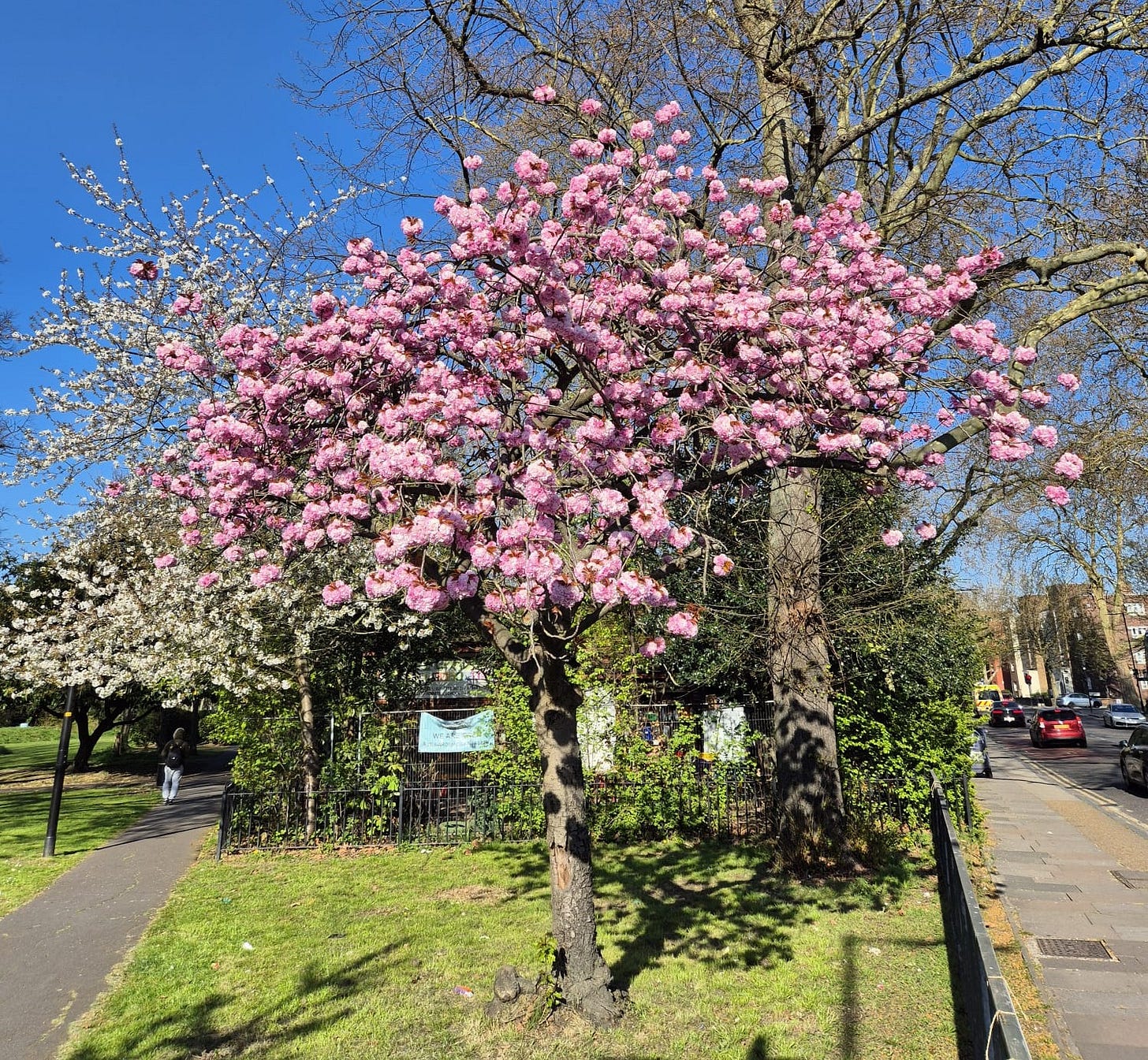
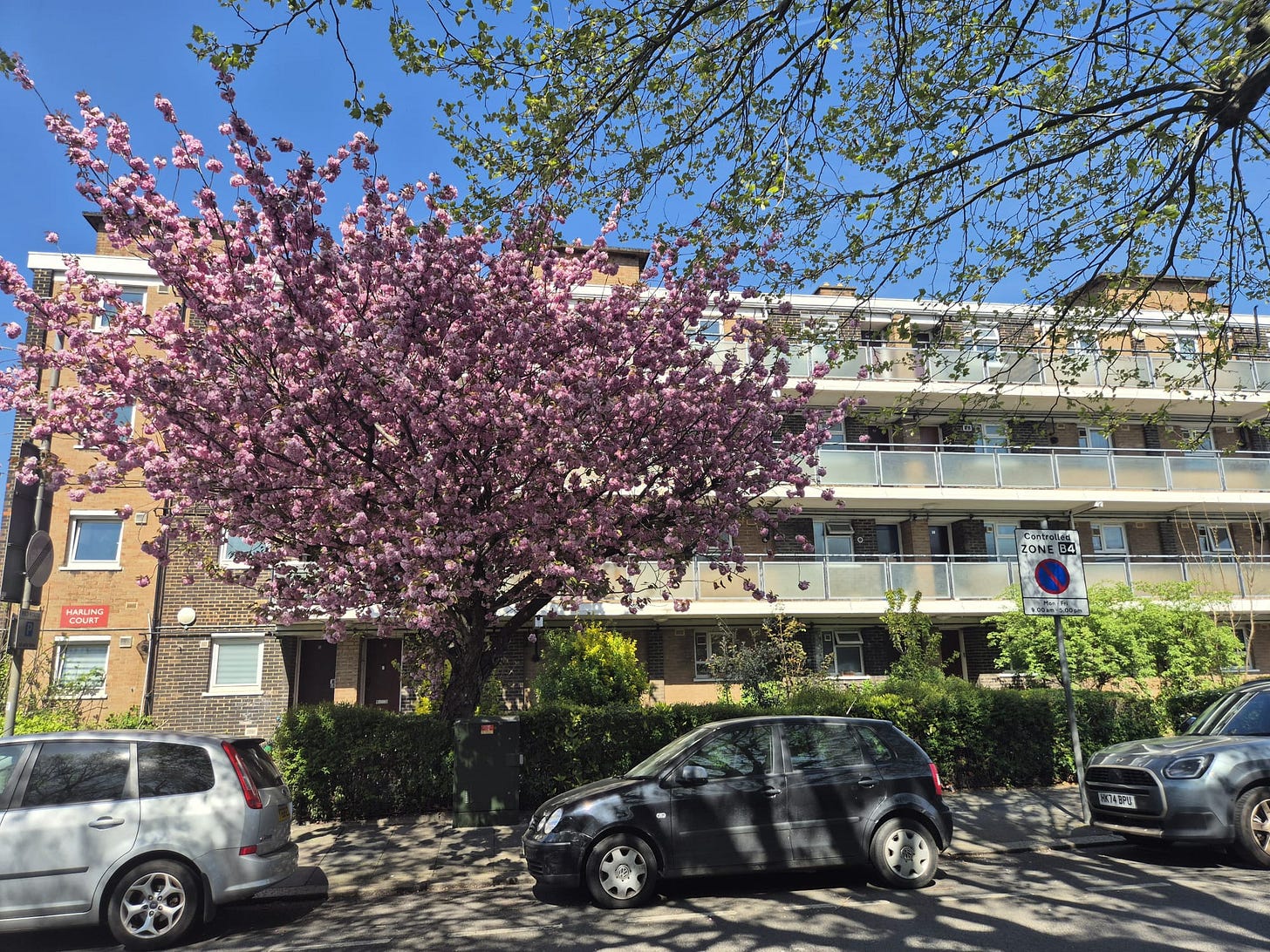

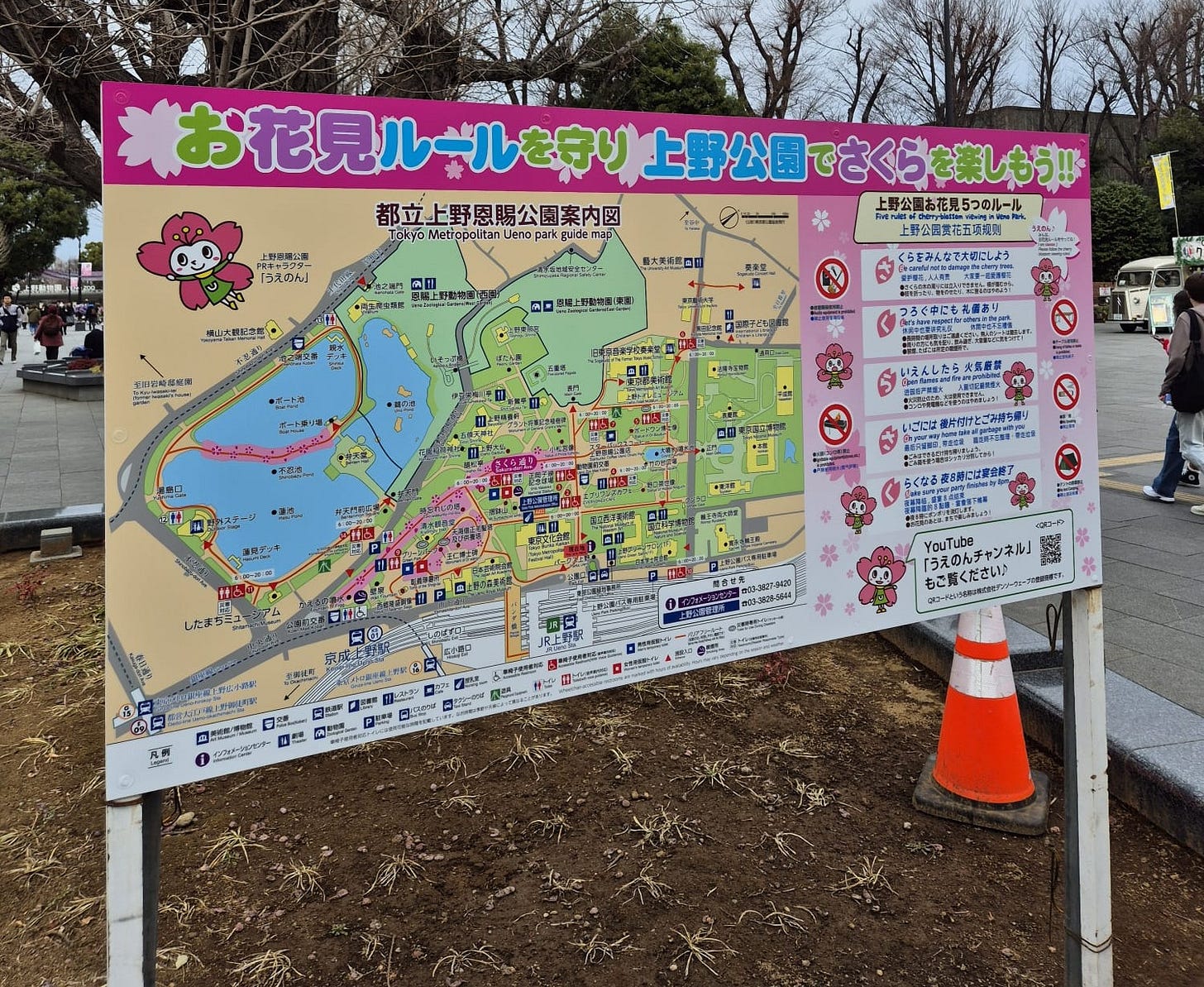

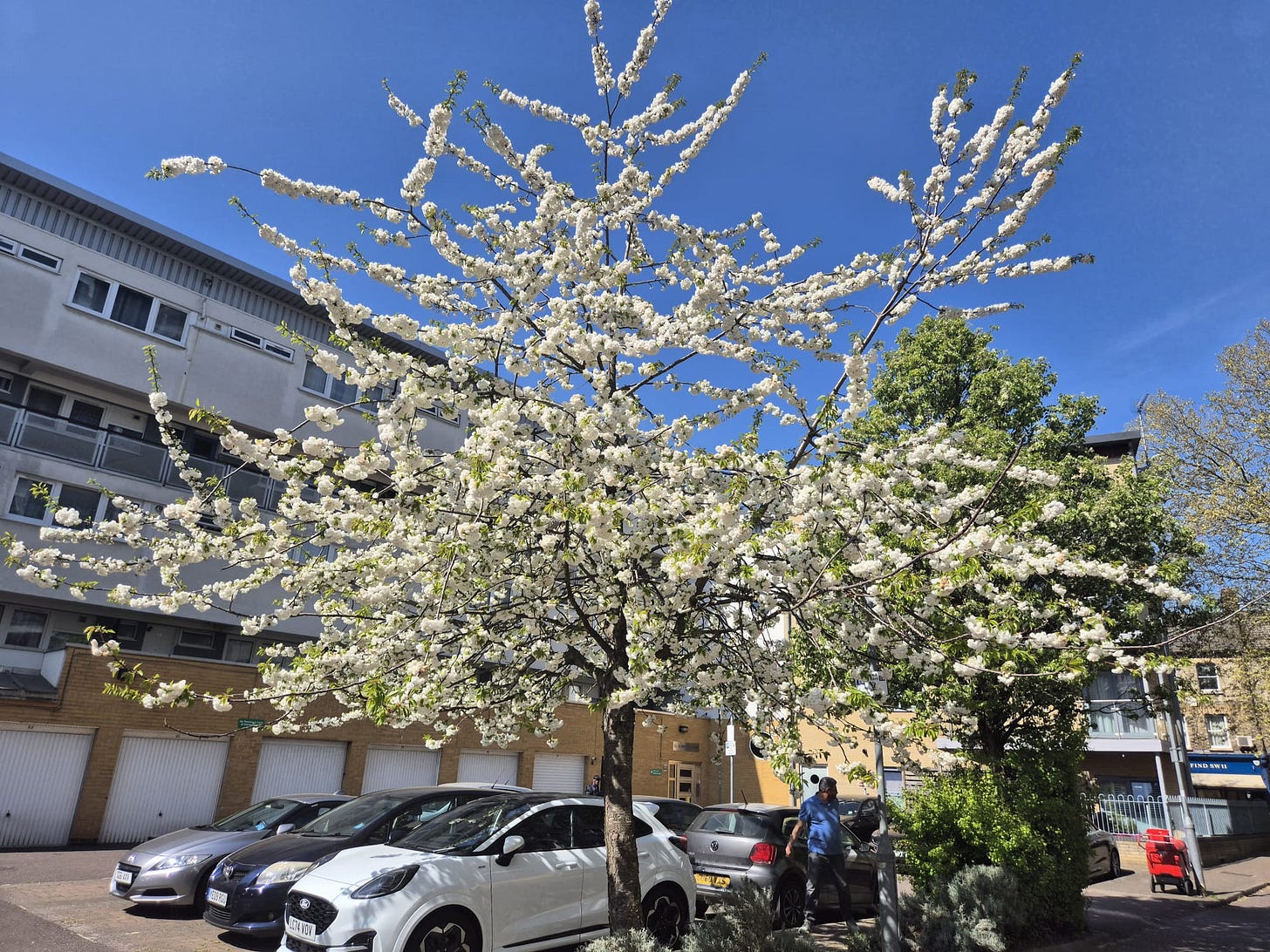

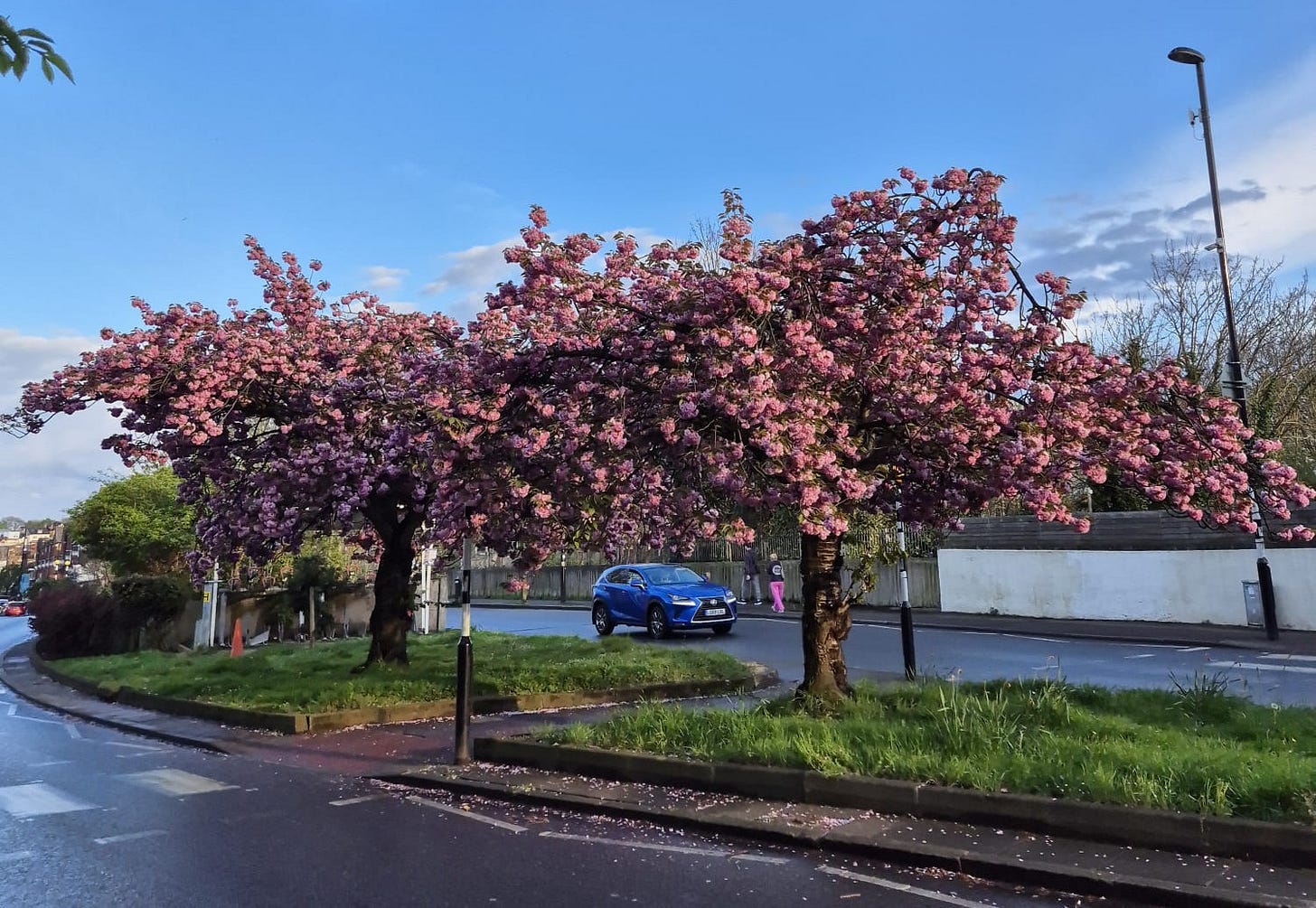
So much pleasure!
Made me smile 😌 not just flowers, nature in general, your theory has weight 😌